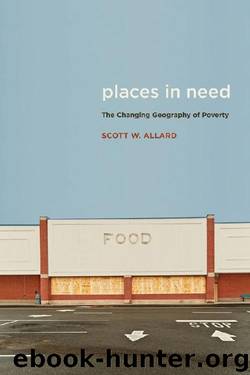Places in Need by Scott W. Allard & Scott Allard

Author:Scott W. Allard & Scott Allard [Allard, Scott W.]
Language: eng
Format: epub
ISBN: 9781610448659
Publisher: Russell Sage Foundation
Published: 2017-06-19T16:00:00+00:00
Local variation in nonprofit service provision is striking and important to consider for many reasons. First, the nonprofit capacity of the safety net does not to appear to have expanded commensurate with rising poverty. Second, there remain stark differences in the resources available to the urban versus the suburban poor. Even with evidence of some convergence between urban and suburban areas since 2000, the disparities between urban and suburban places persist. It is even more unlikely that the regional differences between urban and suburban areas will be narrowed at any point in the coming decades. These analyses also reveal the heterogeneity in the experiences and capacity of different counties. It may be that some counties benefit from regional providers that submit 990 forms from other locales, but the absence of registered nonprofits is indicative of a weak local nonprofit infrastructure.
Conclusion
In many ways, the antipoverty safety net of the early twenty-first century is a far more formalized and robust system than was the case thirty years ago, when back-to-back recessions in the early 1980s led to dramatic increases in poverty across the United States over the decade. Federal programs like SNAP and the EITC, along with public health insurance programs like Medicaid and CHIP, now provide billions of dollars of assistance and aid to tens of millions of families each year. In the early 1980s, spending for these programs was a fraction of what it is today, as were the caseloads. Public and private funding for social service programs targeted at low-income populations is also much higher today than thirty years ago. For example, federal expenditures for a larger set of human service programs than discussed here increased from $47 billion to $110 billion from 1975 to 2002 (in 2006 dollars).86 But some aspects of the safety net have not expanded. Welfare cash assistance, then AFDC, now TANF, has become a smaller program of assistance. As eligibility restrictions and punitive sanctions have become more commonplace, low-income households have sometimes been prevented from accessing safety net programs. Funding for place-based, housing, and community development programs has fallen or flattened over time. At the end of the Obama administration, however, a larger and more predictable bundle of safety net resources is available to poor people than twenty or thirty years ago. Any cuts to these critical public assistance programs will ensure the safety net is less responsive to economic downturns in the future.
As we see in this chapter, however, not all safety net assistance is provided consistently across geography. In this chapter, I have found evidence that certain types of safety net programs—those that are federally funded and most directly regulated at the federal level—are most responsive to the shifting geography of poverty. Programs with greater subnational or local discretion—such as TANF or a host of community-based nonprofit service programs—appear to be much less responsive. Such findings are consistent with the argument that the safety net has focused capacity-building efforts, particularly in nonprofit human services, on urban centers. The weaker response of suburban
Download
This site does not store any files on its server. We only index and link to content provided by other sites. Please contact the content providers to delete copyright contents if any and email us, we'll remove relevant links or contents immediately.
The Secret History by Donna Tartt(18849)
The Social Justice Warrior Handbook by Lisa De Pasquale(12142)
Thirteen Reasons Why by Jay Asher(8796)
This Is How You Lose Her by Junot Diaz(6794)
Weapons of Math Destruction by Cathy O'Neil(6146)
Zero to One by Peter Thiel(5686)
Beartown by Fredrik Backman(5599)
The Myth of the Strong Leader by Archie Brown(5425)
The Fire Next Time by James Baldwin(5249)
How Democracies Die by Steven Levitsky & Daniel Ziblatt(5128)
Promise Me, Dad by Joe Biden(5087)
Stone's Rules by Roger Stone(5026)
A Higher Loyalty: Truth, Lies, and Leadership by James Comey(4845)
100 Deadly Skills by Clint Emerson(4840)
Rise and Kill First by Ronen Bergman(4704)
Secrecy World by Jake Bernstein(4646)
The David Icke Guide to the Global Conspiracy (and how to end it) by David Icke(4625)
The Farm by Tom Rob Smith(4438)
The Doomsday Machine by Daniel Ellsberg(4416)
